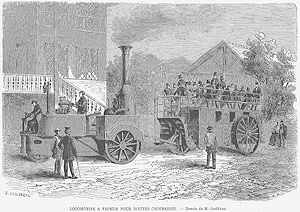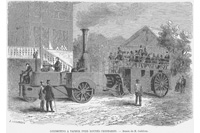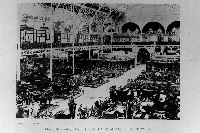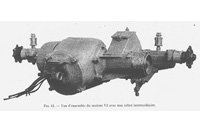Automobile
 This is an image of a steam automobile carrying passengers to the venue of the Paris International Exposition of 1867. With a driver and a boiler man on board, as well as with a chimney protruding, the automobile gave the image of a steam locomotive rather than that of an automobile.
This is an image of a steam automobile carrying passengers to the venue of the Paris International Exposition of 1867. With a driver and a boiler man on board, as well as with a chimney protruding, the automobile gave the image of a steam locomotive rather than that of an automobile.
The first mechanically powered automobile was a steam automobile made in France in 1769 for transporting cannons. Unfortunately, during its test drive, the automobile collided with a wall, causing the world's first car accident.
In England, in 1801, R. Trevithick developed an automobile with a high pressure steam engine. Approximately 20 years later, this kind of engine was used as a driving force for buses. However, high bus fares and strict regulation of running speeds by law prevented the development of steam automobiles in the country.
During that time, steam automobile were developed in France and the United States. In France, after 1828, freight cars, tractors and two-wheeled vehicles with steam engines were developed. In 1873, A. Bollee, touted as the father of steam automobiles, created an eight-seat steam bus, followed by the development of research on the weight reduction. In the United States, the history of steam automobile development began with the creation by O. Evans of an amphibious steam dredge car running on rails in 1805. This was followed by the progress of research on performance improvement through size and weight reduction, resulting in mass production. Around 1850, a combination of a quick-start boiler and an oil burner was devised. Also, weight reduction was realized through the use of pipe frames and radial spoke wheels. This resulted in the manufacture of high-performance cars with an external appearance and mechanism similar to that of gasoline automobiles.
Subsequently, along with the development of internal combustion engines, the world entered the age of gasoline automobiles. In 1885, in Germany, with the support of W. Maybach, an engine designer, G. Daimler created a two-wheeled vehicle with a 0.5 horsepower engine. In 1886, also in Germany, C. F. Bentz created a three-wheeled vehicle (0.9 horsepower), regarded as the first practical gasoline engine automobile. Subsequently, as indicated by his obtaining of a patent for a steering device in 1891, Bentz Co. manufactured automobiles with an emphasis on their unity as a driving machine. At the same time, as indicated by his manufacture of modern carburetors and four-cylindered 10-horsepower engines, Daimler Co. promoted the development with a focus on engines. Both companies exhibited their products at the fourth Paris International Exposition of 1889.
In 1891, the front-engine driving system, which formed the cornerstone of automobiles, and automobile pneumatic tires were developed. Meanwhile, in the 19th century, gas automobiles and electric automobiles were developed, although they did not become mainstream. Between the late 19th century and the beginning of the 20th century, many major manufacturers were established in Europe and the United States, which was soon followed by the coming of the age of automobiles.
Automobile (3 images)
 |
 |
 |
| Steam Automobile Operated at the Exposition Venue | Exhibition of Automobiles | Postel-Viney's V2 Motor for Small-sized Automobiles |
- References:
Arai, Hisaharu.: Jidosha no hattatsushi: Rutsu kara gendai made. 1 (Sankaido, 1995) <NC23-E790>
Eckermann, Erik; Matsumoto, Renpei (tr).: Jidosha no sekaishi (Guranpuri shuppan, 1996) <NC23-G227>
Higuchi, Kenji.: Jidosha gijutsushi no jiten (Asakura shoten, 1996) <NC23-G117>
Lewis, Albert L, Musciano, Walter A; Tokudaiji, Aritsune (tr).: Sekai jidosha zukan: Tanjo kara gendai made (Soshisha, 1980) <NC23-253>

